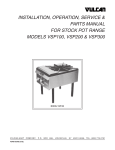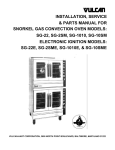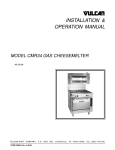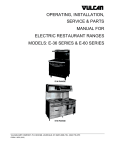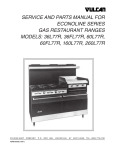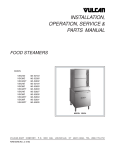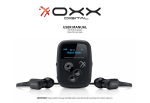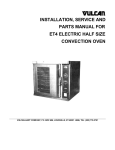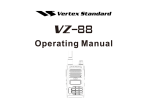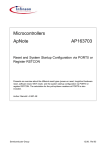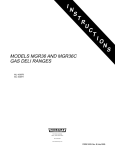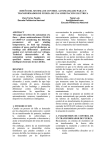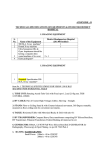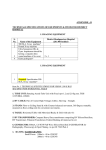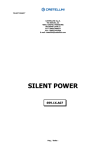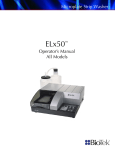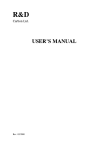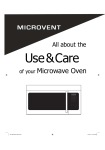Download SG-2 VHL002
Transcript
INSTALLATION AND SERVICE AND PARTS MANUAL FOR SNORKEL GAS CONVECTION OVEN MODELS: SG-2, SG-10, VULCAN-HART CORPORATION, 3600 NORTH POINT BOULEVARD, BALTIMORE, MARYLAND 21222, TEL. (301)284-0660 IMPORTANT OPERATING, INSTALLING AND SERVICE PERSONNEL Operating information for this equipment has been prepared for use by qualified and/authorized operating personnel. All installation and service on this equipment is to be performed by qualified, certified, licensed and/ authorized installation or service personnel, with the exception of any part marked with a ? in front of the part number. Service may be obtained by contacting the Factory Service Department, Factory Representative or Local Service Agency. DEFINITIONS QUALIFIED AND/OR AUTHORIZED OPERATING PERSONNEL Qualified or authorized operating personnel are those who have carefully read the information in this manual and are familiar with the equipment's functions or have had previous experience with the operation of the equipment covered in this manual. QUALIFIED INSTALLATION PERSONNEL Qualified installation personnel are individuals, a firm, corporation or company which either in person or through a representative are engaged in, and are responsible for: 1. The installation of gas piping from the outlet side of the gas meter, or the service regulator when the meter is not provided, and the connection and installation of the gas appliance. Qualified installation personnel must be experienced in such work, be familiar with all precautions required, and have complied with all requirements of state or local authorities having jurisdiction. Reference in the United States of America - National Fuel Gas Code ANSI Z223.1 (Latest Edition). In Canada - Canadian Standard CAN/CGA-B149.1 NAT. GAS (Latest Edition) or CAN/CGA-B-149.2 PROPANE GAS (Latest Edition). 2. The installation of electrical wiring from the electric meter, main control box or service outlet to the electric appliance. Qualified installation personnel must be experienced in such work, be familiar with all precautions required, and have complied with all requirements of state or local authorities having jurisdiction. Reference: In the United States of America - National Electrical Code ANSI NFPA No. 70 (Latest Edition). In Canada - Canadian Electric Code Part 1 CSA-C22.1 (Latest Edition). 3. The installation of steam piping from the source of supply to the service inlet of the appliance. Qualified installation personnel must be experienced in such work, be familiar with all precautions required, and have complied with all requirements of state or local authorities having jurisdiction. QUALIFIED SERVICE PERSONNEL Qualified service personnel are those who are familiar with Vulcan equipment who have been endorsed by the Vulcan-Hart Corporation. All authorized service personnel are required to be equipped with a complete set of service and parts manuals and stock a minimum amount of parts for Vulcan equipment. IMPORTANT NOTES FOR ALL VULCAN APPLIANCES_____________ 1. These units are produced with the best possible workmanship and material. Proper installation is vital if best performance and appearance are to be achieved. Installer must follow the installation instructions carefully. 2. Information on the construction and installation of ventilating hoods may be obtained from the "Standard for the installation of equipment for the removal of smoke and grease laden vapors from commercial cooking equipment," NFPA No. 96 (latest edition) available from the National Fire Protection Association, Battery March Park, Quincy MA 02269. 3. For an appliance equipped with a flexible electric supply cord, the cord is equipped with a three prong (grounding) plug. This grounding plug is for your protection against shock hazard and should be plugged directly into a properly grounded three-prong receptacle. Do not cut or remove the grounding prong from this plug. If the appliance is not equipped with a grounding plug, and electric supply is needed, ground the appliance by using the ground lug provided (refer to the wiring diagram). (FOR GAS APPLIANCES ONLY) 4. Do not obstruct the air flow into and around the appliance. This air flow is necessary for proper combustion of gases and for ventilation of the appliance. Provisions for ventilation of incoming air supply for the equipment in the room must be in accordance with National Fuel Gas Code ANSI Z223.1 (latest edition). 5. Do not obstruct the flow of flue gases from the flue duct (when so equipped) located on the rear (or sides) of the appliance. It is recommended that the flue gases be ventilated to the outside of the building through a ventilation system installed by qualified personnel. 6. For an appliance equipped with casters, (1) the installation shall be made with a connector that complies with the Standard for Connectors for Movable Gas Appliances, ANSI Z21.69 (latest edition), and Addenda, Z21.69a (latest edition), and a quick-disconnect device that complies with the Standard for Quick-Disconnect Devices for Use With Gas Fuel, ANSI Z21.41 (latest edition), and Addenda, Z21.41a (latest edition) and Z21.41b (latest edition), and (2) adequate means must be provided to limit the movement of the appliance without depending on the connector and the quick-disconnect device or its associated piping to limit the appliance movement. If disconnection of the restraint is necessary, reconnect this restraint after the appliance has been returned to its originally installed position. 7. The appliance and its individual shutoff valve must be disconnected from the gas supply piping system during any pressure testing of that system at test pressures in excess of 1/2 psig (3.45 k Pa). 8. The appliance must be isolated from the gas supply system by closing its individual manual shutoff valve during any pressure testing of the gas supply system at test pressures equal to or less than 1/2 psig (3.45 k Pa). CAUTIONS FOR YOUR SAFETY DO NOT STORE OR USE GASOLINE OR OTHER FLAMMABLE VAPORS AND LIQUIDS IN THE VICINITY OF THIS EQUIPMENT OR ANY OTHER APPLIANCE. 1. KEEP THE APPLIANCE FREE AND CLEAR FROM ALL COMBUSTIBLE SUBSTANCES. 2. IN THE EVENT A GAS ODOR IS DETECTED, SHUT UNIT(S) DOWN AT THE MAIN SHUTOFF VALVE AND CONTACT THE LOCAL GAS COMPANY OR GAS SUPPLIER FOR SERVICE. 3. POST IN A PROMINENT LOCATION, INSTRUCTIONS TO BE FOLLOWED IN THE EVENT THE SMELL OF GAS IS DETECTED. THIS INFORMATION MAY BE OBTAINED FROM A LOCAL GAS SUPPLIER. CAUTIONS (Continued) CLEARANCE: FROM THE TERMINATION OF THE APPLIANCE FLUE VENT TO THE FILTERS OF THE HOOD VENTING SYSTEM, AN 18 INCH MINIMUM CLEARANCE MUST BE MAINTAINED. REFERENCE: ANSI/NFPA 96-1980 4-1.2.2.2 OF THE NATIONAL FIRE PROTECTION ASSOCIATION, INC., BATTERYMARCH PART, QUINCY, MASS. 02269. AND NATIONAL BUILDING CODE 1976 SEC. 1015.7b (2) OF THE AMERICAN INSURANCE ASSOCIATION, ENGINEERING AND SAFETY SERVICE, 85 JOHN STREET, NEW YORK, N.Y. 10038. LOADING: BEFORE LOADING THE OVEN SET THE LOAD CONTROL DIAL TO THE PROPER SETTING FOR THE PRODUCT AND THE COOKING LOAD (SEE SEPARATE COOKING CHART). OPENING OVEN DOORS: BEFORE OPENING THE OVEN DOORS, PUSH THE AUXILIARY FAN SWITCH TO THE "OFF" POSITION. OPENING THE OVEN DOORS WILL AUTOMATICALLY CUT "OFF" THE FAN AND THE HEATING ELEMENTS, BUT IF THE FAN SWITCH IS NOT PUSHED TO THE "OFF" POSITION, HOT AIR GATHERED WITHIN THE OVEN CAVITY MAY BE PUSHED OUT WHEN THE DOORS ARE OPENED. CAUTION: DO NOT STAND DIRECTLY IN FRONT OF THE OVEN WHILE OPENING DOORS. WHEN OPENING THE DOORS, THE OPERATOR SHOULD PULL THE DOOR HANDLES OPEN WHILE SIMULTANEOUSLY STEPPING BACK AWAY FROM THE FRONT OF THE UNIT. LOAD THE OVEN AS QUICKLY AS POSSIBLE TO CONSERVE HEAT. CENTER PANS ON THE RACKS. HI LIMIT: THE HI LIMIT IS A PROTECTION DEVICE WHICH SENSES THE TEMPERATURE OF THE UNIT TO PREVENT APPLIANCE OVERHEATING. THE HI LIMIT OPERATES INDEPENDENTLY AND WILL AUTOMATICALLY CAUSE UNIT SHUTDOWN SHOULD THE PRIMARY CONTROL FAIL. IF THIS SITUATION OCCURS., DO NOT ATTEMPT TO BYPASS THE HI LIMIT. SHUT THE UNIT DOWN AND CONTACT A SERVICE AGENCY. 2 2A SNORKEL™ GAS CONVECTION OVEN INSTALLATION AND SERVICE MANUAL— Your Vulcan Snorkel gas convection oven is produced with the best possible workmanship and material. Proper usage and maintenance will result in many years of satisfactory performance. The manufacturer suggests that you thoroughly read this entire manual and carefully follow all of the instructions provided. DESCRIPTION PAGE DEFINITIONS OF PERSONNEL (Operation, Installation & Service) and SHIPPING DAMAGE CLAIM PROCEDURES CAUTIONS INDEX (Inside Front Cover) 1-2-2A INDEX 3 GENERAL THEORY OF OPERATION 4 INSTALLATION INSTRUCTIONS 5-6-6A TROUBLE SHOOTING - SERVICE 7-8 SERVICE REPLACEMENT COOKING CHART REPLACEMENT PARTS REVISION SHEET Snorkel ranges are supplied with a 7 foot 3 wire supply cord. Appliances are equipped with a three prong (grounding) plug for your protection against shock hazard and should be plugged directly into a properly grounded three prong receptacle. DO NOT cut or remove the grounding prong from this plug. This appliance is to be installed with a six inch clearance at the sides and rear adjacent to combustible construction. 9-12 13-14 15-15A, 16-16A-24 (Inside Back Cover) A rating plate is located on the lower panel stating the model number, type gas, serial number, voltage and amperage. A complete set of wiring diagrams are packed separately in this unit. A wiring decal may be found located inside the control panel compartment. 3 GENERAL THEORY OF OPERATION GENERAL THEORY OF OPERATION Figure 1 shows the air distribution and the path of the flue products in the Vulcan Snorkel oven. There are two tubular sheet metal burners which operate in an insulated combustion chamber with minimum air requirements. The flame chamber collects the heat generated by the burners and directs it through the heat exchanger tubes which are within the cooking compartment. The heated flue products are collected in a box above the oven compartment and directed to the blower inlet through the Snorkel tube. The oven compartment is heated indirectly via the heat exchanger tubes and directly with the flue products drawn into the oven by the Snorkel tube. A circulating fan also distributes heat throughout the oven evenly. The two vents in the top of the oven compartment evacuate moisture and also vent the oven flue products. The blower and solenoid operate independently of each other. The blower operates as long as the doors are closed or the Aux. Fan Switch is actuated. The solenoid is controlled by the thermostat and the Load Control. The thermostat must be On and the Load Control set to an operating position for the 4 Solenoid to come On and supply heat to the oven. Either the Thermostat or the Load Control Switch in Off position will shut off the Solenoid. In order to provide protection against a pilot outage hazard, a safety valve controls the main flow of gas to the burner. As long as a pilot flame is present, the valve will remain open. In the absence of pilot heat, the valve closes, eliminating gas to the burner. Each burner has its own valve which allows them to operate independently of each other. A snap acting door switch, mechanically linked with the right hand door, shuts off both the heat and the blower when the door is opened and will automatically reset when the door is closed. In ovens equipped with optional Aux. Fan Switch, the door interlock can be over-ridden by depressing the "Aux. Fan Switch." The over-ride affects the blower only (not the heat) and is intended for rapid cooling of the oven interior. Under "Component Description and Replacement" section the detailed function of each component is explained. INSTALLATION INSTRUCTIONS This appliance when installed must be electrically grounded in accordance with National Electrical Code ANSI C1-1981. Vulcan ovens are produced with the best possible workmanship and material. Proper installation is vital if best performance and appearance is to be achieved. Please follow these instructions carefully. 1. Remove crating with care. Remove all wood blocking, packing material and accessories. 2. Each unit is factory equipped and electrically connected for use with type of gas and electric supply indicated on rating plate behind the lower panel. Check type of gas and electric supply available. 3. Secure oven to stand with two bolts at front (refer to Detail A). Position unit as near to final location as possible. 4. Pipe Joint compounds used when connecting appliances to gas should be resistant to the action of L.P. Gases. SECTION 1 5. Pipe Joints should be tested for leaks with a soap and water solution before operating the unit. 6. Connect oven to gas supply through shut-off valve and gas pressure regulator provided. Units for use on natural gas are equipped with a regulator with a preset outlet pressure of 3.7" water column. Units for use on propane gas have a regulator with a preset outlet pressure of 10.0" water column. Regulator must be mounted horizontally to provide the preset outlet pressure. If regulator is mounted in any other position, the outlet pressure must be reset. Note: Do not obstruct leak limiter on gas pressure regulator. 7. Connect oven to electric supply. 115 volts ovens single phase units are equipped with a 7 ft. 3 wire (including ground) supply cord. 115 volt appliances are equipped with a three prong (grounding) plug for your protection against shock hazard and should be plugged directly into a properly grounded three prong receptacle. Do not cut or remove the grounding prong from this plug. 208/240 volt units with a single or three phase motor are provided with a terminal block. 208/240 volt units must be electrically grounded at time of installation. 8. Install draft diverter if required. Either a draft diverter or low profile deflector is shipped with every oven. Low profile deflector is intended for use when oven is installed under canopy type hoods. When the oven is directly connected to a vent system, a down draft diverter must be used. 9. When mobile carriers or basket dollies are to be used, the standard oven racks and supports are left out. Mobile carriers or basket dollies are for use in SG-10, SG-10SM, only. A. The cart used to transport mobile carriers and basket dollies has a guide and locking device to align runners on cart with runners on oven deck. 5 INSTALLATION INSTRUCTIONS (Cont'd) B. When using 18 x 26 pans with single rack carrier, the racks are not required. Engage 18 x 26 pan rim on rack carrier runners. The oven deck height should now be adjusted to align with cart height. pilot burner. If pilot does not light, turn gas off, wait 5 minutes and repeat steps 1 thru 5 of 12A. It is not necessary to repeat pilot lighting everyday. For units with electronic ignition, pilot lighting is not necessary. The main burners are ignited by spark when thermostat is turned on. 10. Using a carpenter level placed on a rack, adjust the B. Units with electronic ignition: feet on the bottom of each leg, so that oven is level from front to back and side to side. This must be done with either standard rack supports or optional extra mobile carriers when used. No pilot lighting is necessary. Main burners are ignited by spark when thermostat is turned on. 13. To shut down unit, turn off master switch and turn off gas at the service valve. To relight repeat step 12A or 12B. (NOTE: LEVEL OVEN WHEN IN PERMANENT POSITON ONLY.) 11. Turn on gas. Purge gas line to remove air. Check for leaks. Caution: Use soap solution or similar means (do not check with open flame). 12A. PILOT LIGHTING INSTRUCTIONS: Units with Standing Pilots (Ref. to Detail "B"). 1. If pilot light is out, turn master switch off, open doors, then wait 5 minutes before relighting. 2. Light pilot with taper. 3. Turn Master Switch to On position. 4. Set thermostat control knob to desired temperature. (See Cooking Chart for ref.). 5. Set load control to proper setting. (See Cooking Chart for ref.) 6. For daily shutdown, turn master switch, thermostat knob, and load control knob to "Off" position. 7. For seasonal shutdown, extinguish pilot, turn master switch, thermostat knob and load control knob to "Off" position. NOTE: Pilot burner flames are preset at the factory before shipping approximately 1/2" high. Flame should impinge on sensing bulb located directly below each Caution: Fan must rotate clockwise when vi ewed through the oven door. On three phase motor units, fan rotation can be reversed by interchanging any two power supply leads. On single phase units with incorrect fan rotation, contact factory. FLUE CONNECTIONS Good ventilation, which includes flue connections and room drafts, is just as important for correct oven operation as adequate gas supply. Generally speaking, ovens should never be directly flue connected, if a direct flue system can be avoided. The ideal method of ventilating a Convection oven is the use of a properly designed hood. Hood should extend about 6" beyond all sides of the appliance. The hood should be connected to an adequate exhaust duct or system. When ovens are installed in locations with low ceilings, care must be taken to insure proper clearance for the flue products. Lack of this clearance above outlet of rear flue piping will interfere with heat circulation in the oven and could create a fire hazard condition. Refer to NFPA #96. Do not permit fans to blow directly at the oven and wherever possible, avoid open windows next to oven sides or back and wall type fans which create air cross currents within the room. It is also necessary that sufficient room air should be allowed to enter the room to compensate for the amount of air removed by any ventilating system. Otherwise, a subnormal atmosphere pressure will occur, affecting oven operation adversely and causing undesirable working conditions. A properly designed and installed hood will act as the heart of the ventilating system for the room or area in which the oven is installed, and will leave the oven independent of changing draft conditions. 6 INSTALLATION INSTRUCTIONS (Cont'd) RECOMMENDED USE OF CONTROLS IN DETAIL C (FOR ROAST AND HOLD OVENS) 1. MOISTURE VENT DAMPER: (NOT SHOWN) Pull damper knob out to open damper releasing excess moisture generated while cooking products with high moisture content. Close damper when dry products are being cooked. Intermediate adjustments permit selection for optimum performance. 2. MASTER SWITCH - ITEM 2 Main on-off switch which converts elec. supply to oven controls. 3. THERMOSTAT SINGLE LIGHT - ITEM 3 Light "On" indicates that oven is preheating or has not recovered in temperature to the dial setting during cooking cycle. 4. THERMOSTAT - ITEM 4 The thermostat is a snap-acting on-off type control. The thermostat regulates the oven temperature from 200° thru 500°. Turn dial clockwise to increase temperature and control counter-clockwise to decrease temperature. NOTE: All heating elements are under supervision of the thermostat. 5. LOAD CONTROL LIGHT - ITEM 5 Light "On" indicates load control is operating in the range between the high and low settings. 6. LOAD CONTROL - ITEM 6 An infinite switch which permits variation of the heat input between off and 100 percent of the input. DIAL SETTING HI HlMED+ MED MEDLO+ LO OFF PERCENT OF FULL INPUT 100% 83% 72% 60% 48% 37% 27% 0% 8. FUNCTION SWITCH - ROCKER SWITCH ITEM 8 Puts oven in normal or roast & hold mode. 9. ROAST TIMER — 5 HOUR (OPTIONAL 12 HR.) ITEM 9 Used to set the time interval for the roasting portion of the roast & hold cycle. When timer times out to "H", the timer switches the temperature control of the oven from the adjustable thermostat (main) to the fixed (160°) thermostat for the holding portion of the cycle. 10. OVEN LAMP SWITCH - (NOT SHOWN) Rocker switch controls interior oven lights. Turn on lights only when loading, unloading or checking product. Continual burning of lights will result in short bulb life. (Bulb replacement not covered under warranties). 12. AUXILIARY FAN SWITCH - (NOT SHOWN) 7. ONE HOUR TIMER - ITEM 7 Select for any time interval up to one hour. At the end of selected interval, an electric buzzer will give a continuous signal. Turn timer to hold position to stop buzzer or when timer is not in use. Controls operation of fan when doors are in open position. This permits rapid cooling of oven. Use when next load is to be cooked at a much lower temperature than load just completed. 6A TROUBLE SHOOTING — SERVICE The following is intended to provide a guide for trouble shooting procedure and covers some of the more common problems with the equipment. The servicing personnel, as with any other equipment, need to become If no voltage, the Master Switch is defective. If 115 volt, check for bad connection from the switch terminal to the Thermostat and motor connections. familiar enough with the circuit and the components in order to be able to follow a logical sequence of trouble- Step B — Only the door switch can disable the blower and heat at the same time. While opening and closing the right hand door listen for a click near the top of the right shooting, and repair malfunctions not mentioned in the following paragraphs. hand door. If no click, the door switch requires adjustment. If the switch does click but no heat or blower, The instruments necessary for trouble-shooting would be: A. A.C. Voltmeter to measure line voltages up to 480 volt. the switch may be defective. B. A.C. Amp-meter to measure line currents. C. Accurate Thermometer to measure oven temperature Problem: 2. The blower is "ON" (with aux. fan switch de-energized) but no heat. up to 500°F. In the following paragraphs, the voltmeter is used to measure the voltage between 2 phases on 208, 240, 480 volt and between one phase and neutral on 220/380 and 240/415 volt supplies. Do not measure the voltage with respect to the chassis ground. For the sake of simplicity, the measured voltage is referred to 115 volt, assuming that the supply is 115 volt. When supply is 240 or 220, the measured voltage should also be 240 or 220—it is also assumed that the voltage rating of the oven matches exactly (within the allowable supply tolerance) that of the field supply. Refer to the appropriate wiring diagram at the end of this booklet for reference. With the main power and oven circuit breakers "ON", the master switch turned to "ON" position and the oven door closed: Problem: 1. No blower, no heat Procedure: Depress the Oven Light switch or turn timer knob to "0" position. If the lights come On and the Buzzer sounds, follow step B. If not, follow step A. Step A—Measure voltage between leads 93 and 94 (The supply side) of the Master Switch. If no voltage check connection to Power Supply cord and verify power at wall socket. If 115 volt, measure voltage across 21 and 22. 7 Procedure: Turn thermostat knob to about 400°F. position. If oven signal light is turned "ON," follow step A; if not, follow step B. Step A — Oven indicator light is "ON." This is an indication that the door switch, and the thermostat are functioning properly. The problem can then be related to the load control switch or the solenoid. Turn the load control knob to "HI" position. Check the voltage between terminals L1 & L2 of the load control switch. If no voltage, check for bad connection or faulty lead to the switch. If 115 volt, check voltage across H1 & H2 terminals of the switch. If no voltage, the switch is defective. If 115 volt, check for defective solenoid or faulty connection between the load control and the solenoid. Step B — Oven Indicator Light does not come "On". This is an indication that the door switch, load control or thermostat could be defective. (Check for a bad connection between the master switch and the thermostat, defective thermostat or bad connection between the normally open contact of the door switches and leads going to the solenoids. TROUBLE SHOOTING—SERVICE (Cont'd) Problem: 3. The oven heats up properly when Procedure: The internal thermal protector of the motor empty, but as soon as the food is put in it, the is sensing a high temperature which is caused by: temperature drops and the oven never recovers. A — Hi current. Check for clockwise rotation of shaft, for any binding on the shaft or the blower wheel (the wheel Procedure: Meals containing excessive moisture can cause the temperature to drop. Also, a cause of temperature drop is excess load. should be rotated freely by a hand touch.) If none of the above, the motor may be defective. Refer to the Cooking Chart to insure that the load is of the B—Hi ambient. Check for hot air leakage from inside the oven to the back through the light or motor housings. recommended capacity for the oven in use. Check to see if hot air is blown to the motor from the adjacent equipment. Problem: 4. The oven temperature keeps increasing beyond the setting of the thermostat. Procedure: If the thermostat indicator light cycles on and off, check for defective solenoid. Check for proper ventilation in the area. 208-240 volt units note: Sometimes the over current affects the circuit breaker (15 amp breaker) before it does the thermal protector; and the circuit breaker keeps tripping to the "OFF" position. If the thermostat light remains "ON" check for defective thermostat (contacts welding) Problem: 5. The motor turns off and automatically comes back "ON" after a few minutes. 8 SERVICE REPLACEMENT REPLACEMENT PARTS ORDERING The following information must accompany a replacement parts order or it cannot be filled. A. Model and Style or Serial Number. B. Voltage and Phase. C. Appliance Finish: Permafinish, Stainless Steel, etc. (If applicable to part to be replaced.) This information can be found on the instruction plate on the unit. Parts may be ordered from your dealer, service agency, or the factory. Orders to the factory should be addressed to: Vulcan- Hart Corporation, 3600 North Point Boulevard, Baltimore, MD 21222 Warning: Turn the Main Gas Valve and Power Disconnect Switch to OFF before servicing the equipment. Reconnect the leads of the replacing components exactly to the original position and reverse procedure for adding the new component. 1. SWITCH PANEL Pushing through the front face of the Switch Panel until spring clips lock into place. • Reconnect wires to proper terminals. B. Replacement of Thermostat • Remove Rear Body Top. • Remove the Thermostat Bulb from its (2) retaining clips located in the right rear corner of oven cavity. • Push Bulb and Capillary Tube through Grommet in cavity top. • Push Bulb and Capillary through hole in Switch Panel Compartment. • Remove Silicone tubing from Capillary and save for reinstallation. • Disconnect wires from Thermostat. Remove control knobs and mounting screws. Pull Thermostat off back of panel. • When reinstalling Thermostat, reverse procedure listed above. Do not kink Capillary or place sharp bend in Bulb. Thermostat Calibration Check • Use a calibrated potentiometer with a thermocouple located in the center of the fan guard assembly. Remove two screws from rear flange of Switch Panel louvered cover. Push cover back exposing Switch Panel components. • Set Thermostat Knob to a mid range temperature. • Allow adequate time for the temperature to stabilize. A. Replacing Rocker Switches and Indicator Lights • Remove knob from dial shaft B, Detail B. • Turn screw A clockwise to decrease temperature and counterclockwise to increase temperature. Note: 1/4 turn of screw A represents a temperature shift of 35 degrees F°. • Remove all wire connections to component. Make a note of terminal positions. • Compress spring clips on top and bottom of component while forcing it out the front of the Switch Panel. Thermostat Calibration • Replace component in the original position by 9 SERVICE REPLACEMENT (Cont'd) C. Load Control. A D.P.S.T. cycling Switch varies, according to its setting, the percent on-time of the output as shown below: To replace, remove the knob and the lock-nut—reinstall same as Item C. 2. BLOWER MOTOR The Blower Motor has internal thermal protection, and its sealed bearings do not require any lubrication. The Load (Element Contactor or Solenoid) Valve) Dial Setting Percent On-Time Hi 100 Hi-83 Med+ 72 Med 60 Med-48 Lo+ 37 Lo 27 Off 0 mounting of the Blower Assembly allows servicing from inside the oven as follows: Remove Fan cover. Loosen set screw on airotor with allen wrench. Pull airotor forward off of the Motor Shaft with wheel puller. Remove the (4) nuts holding the motor mounting plate. Pull the motor assembly forward and rest on cavity bottom. INFINITE LOAD CONTROL SWITCH The Load Control, as shown schematically, is connected in series with the thermostat, thus providing variable rate of temperature rise to reach the thermostat setting, as well as maintaining at the final set temperature. Therefore, with load control set at Lo, it will take much longer to reach a desired temperature than with a setting of Hi. The cooking chart shows the necessary dial setting for different food products. To replace, remove the knob and the lock nut. To reinstall, make sure the dimples on the face of the switch fall in the slot of the switch panel in order to prevent it from rotating. D. Timer (one or five-hour models). The normally open and common contacts of the electric timer are connected together, energizing the timer motor when the knob is set to the desired position. Once the timer completes its set interval (at zero mark) the common terminal disconnects from timer motor (shuts the motor off) and connects with the buzzer. The buzzer will continue to sound until the knob is manually turned to 'Hold' position where all contacts are opened (timer motor and buzzer turned off). Remove the junction box cover and supply leads. Rest the motor on its back. Remove the (4) flat head screws, lockwashers, nuts and spacers used to fasten the Motor Mounting Plate to the Motor. To install new motor reverse above procedure. Caution: The motor is suitable for connection to two different voltage supplies. Check the connection instruction inside the Motor Junction Box Cover to assure proper connection for the available voltage supply. The direction of rotation is clockwise as viewed from inside the Oven. The 1-phase Motors are internally designed for C.W. rotation. On 3-phase Motors, interchange any two supply leads to convert C.C.W. to C.W. rotation. 3. OVEN LIGHTS The two 50 watt, 115 volt bulbs are connected in series in the Electric and in parallel in the Gas Convection Ovens. 10 SERVICE REPLACEMENT (Cont'd) SHUT-OFF VALVE SERVICE The gas shut off valve is located at the rear of the unit and should be used to shut the unit down when service is required to gas components. This valve should also be used to turn all gas off to the unit when the unit is being shut down for an extended period of time. If the shut off valve requires service this may be accomplished only by turning off the gas supply upstream of the valve. PRESSURE REGULATOR SERVICE The pressure regulator is located at the rear of the unit downstream of the shut off valve. If the pressure regulator requires service, this may be accomplished by turning off the gas supply upstream of the shut-off valve and pressure regulator and then removing both of these parts. effort to correct problems traced to this component, remove and clean the leak limiter. PILOT BURNER ADJUSTMENT Remove lower panel assembly (spring clip mounted) and light both pilot burners. Adjust pilot flame heights to approximately 1/2". Flame should impinge on flame switch sensing bulbs located directly above the pilot burner flames. See Detail B on page 5 for location of pilot. Both pilot valves are located in the front center of the burner compartment. AIR ADJUSTMENT Although main burner air is adjusted before shipment, it should be checked at the time of installation. Excessive air will cause flames to lift off a burner when cold or may cause flash-back during normal cycling of unit, particularly when propane gas is used. Blockage of the pressure regulator leak limiter will result in erratic burner operation and pilot outage. Insufficient air will cause flames to burn with a yellow tip and result in carbon accumulation in the flame chamber and heat exchange tubes. Note: Prior to replacing a pressure regulator, in an FOR ALL UNITS MANUFACTURED AFTER OCTOBER 1, 1983 BURNER ORIFICE DATA MODEL MAXIMUM INPUT PER BURNER PRESSURE REG. SETTING ORIFICE DRILL SIZE SG.2SM. SG.22, SG.2 30,000 6" W.C. #38 GAS NAT. SG.2SM, SG.22. SG.2 30,000 10.0" W.C. #1/16 PROPANE SG.10SM, 35.000 6" W.C. #35 NAT. 35,000 10.0" W.C. #53 PROPANE SG.1010, SG-10 SG-10SM SG.1010. SG.10 FOR ALL UNITS MANUFACTURED BEFORE OCTOBER 1, 1983 BURNER ORIFICE DATA MODEL MAXIMUM INPUT PER BURNER SG.2SM, SG 22 PRESSURE REG. SETTING ORIFICE DRILL SIZE 30,000 3.7" W.C. #36 GAS NAT. SG.2SM, SG 22 30,000 10.0" W.C. #1/16 SG.10SM, SG.1010 35,000 3.7" W.C. #33 NAT. PROPANE SG.10. SG.1010 35.000 10.0" W.C. #53 PROPANE REPLACEMENT OF SOLENOID VALVE, REGULATOR, OR SHUTOFF VALVE FOR MODELS SG-2, SG-10 • Turn off gas supply upstream of unit. • Break gas connection at shut off valve. • Break compression fittings at front manifold. • Remove (4) bolts (inside center chamber) to rear • Disconnect wires to solenoid at wire nuts. • Pull manifold out back of unit. • Remount manifold by reversing procedure listed above. manifold support. REPLACEMENT PARTS ORDERING THE FOLLOWING INFORMATION MUST ACCOMPANY A REPLACEMENT PARTS ORDER OR IT CANNOT BE FILLED. A. MODEL AND STYLE NUMBER. B. TYPE OF GAS. C. APPLIANCE FINISH, BLACK OR STAINLESS STEEL, (IF APPLICABLE TO PART TO BE REPLACED.) THIS INFORMATION CAN BE FOUND ON THE RATING PLATE LOCATED INSIDE THE LOWER FRONT PANEL OF THE UNIT PARTS MAY BE ORDERED FROM YOUR DEALER, SERVICE AGENCY, OR THE FACTORY. ORDERS TO THE FACTORY SHOULD BE ADDRESSED TO VULCAN.HART CORP., 3600 NORTH POINT BLVD. BALTIMORE, MD 21222. 12 COOKING CHART IMPORTANT Recommended temperatures, times, number of racks and load control settings are intended as a guide only. Adjustments must be made to compensate for variations in recipes, ingredients, installation and personal preference in product appearance. RECOMMENDED TEMPERATURES, TIMES AND LOADS FOR ROASTING Meat roasting is most satisfactory at temperatures of 225° to 325° F. for Beef, Lamb, Poultry and Ham; 325° to 350° for fresh Pork as recommended by USDA and American Meat Institute. A pan of water (approximately 12" x 20" x 1") may be placed in the oven bottom. This water supplies humidity to reduce shrinkage. Water should be added if necessary during roasting. Roasting pans should be no deeper than necessary to hold drippings, usually 2" to 2 1/2". Cooking time and shrinkage may vary with roasting temperature, cut and grade of meat and degree of doneness. Smaller cuts will generally show greater time savings than larger cuts at a given temperature. ROASTING TEMPERATURE CHART PRODUCT TEMPERATURE LOAD CONTROL SETTING Standing Rib Roasts—Oven Ready 250° F HI Rolled Rib Roasts—20 to 22 Lbs Veal Roast—15 Lbs Turkeys—15 to 20 Lbs Meat Loaf—8 to 10 Lbs 275° F 300° F 300° F 350° F HI HI HI HI APPROXIMATE TIMES 3 to 4 Hrs —Rare 4 to 4 1/2 Hrs.—Med. 4 Hrs.—Med. 3 Hrs —Med Well 3 Hrs. 45 to 60 Minutes RECOMMENDEDTEMPERATURES, TIMES AND LOADS FOR BAKING (ALL SNORKEL MODELS) PRODUCT Cakes Sheet Cakes 18 x 26 x 1" Scaled 41/2 to 6 Lbs. Per Pan Scaled 6 to 7 1/2 Lbs Per Pan TEMPERATURE TIME IN MINUTES NO. OF RACKS 325° to 360°F 335° to 350°F 20 to 23 22 to 25 5 4 4 Med+ to Med Med to MedMed to Med- 300° to 325° F 25 to 35 3 Med- 300° to 325° F 15 to 20 4 Lo+ 315° to 340° F 350° to 400° 350° to 375° F 20 to 30 6 to 12 30 to 45 Pumpkin or Custard Pies 300° to 350° F 30 to 45 3-4 4 4 3 4 3 Med-to Lo Med to MedMed to MedMedMed to MedMed- to Lo+ Cobblers 12 x 18 x 2" or 12 x 20 x 2 1/2" 350° to 400° F 30 to 45 Sheet Cakes 18 x 26 x 2" Pan Equals 2-12 x 18 x 2" Pans Scaled 10 to 12 Lbs Per 18 x 26 x 2" Pan or 5 to 6 Lbs Per 12 x 18 x 2" Pan Angel or Sponge Cakes Sheet Pans 18 x 26 x 1" Scaled 5 to 6 Lbs Per Loaf or Tube Pans Cup Cakes Frozen Fruit Pies 4 3 Meringue Pies 350° to 425° F 6 to 10 4 3 2 Fruit Turnovers 350° to 375° F 15 to 25 5 18 x 26 x 1" Pans 4 3 Cookies 350° to 400° F 6 to 12 5 Rolled or Pressed 4 3 Drop 350° to 400° F 6 to 15 5 4 3 Brownies 350° F 12 to 20 5 4 Rolls—1 Oz 350° to 400° F 5 to 10 4 3 Rolls—11/2 to 2 1/2 Ozs 350° to 400° F 8 to 15 4 3 Loaf Bread—1 Lb 325° to 375°F 20 to 40 3 (30 Pans) 2 (20 Pans) NOTE: Pies and Cobblers; Fruit, Custard and Pumpkin Pies in tins, should be placed on 18 x 26 x 1" Pans for Baking LOAD CONTROL Med MedMed to MedMed to MedMed to MedMed to MedMed to MedMed-to Lo+ Med to Lo+ Med-to Lo+ Lo+ Med to MedMed-to Lo+ Lo+ Med to MedMed-to Lo+ Med to MedMedMed to MedMed- to Lo+ MedLo* NOTE: This chart is for models: SG-2SM, SG-22, SG-10SM & SG-1010. 13 COOKING CHART (Cont'd) RECOMMENDED TEMPERATURES, TIMES AND LOADS FOR BAKING (ALL SNORKEL MODELS) PRODUCT Yeast Breads Note: Yeast Breads should be fully proofed for best results TEMPERATURE TIME IN MINUTES NO. OF RACKS LOAD CONTROL 4 3 4 3 Med to MedMed- to Lo+ 6 to 18 4 3 MedMed- to Lo* 335° to 400° F 10 to 20 4 Med to Med- 8 to 20 Lbs. Per 18 x 26 x 2" 335° to 400° F 15 to 25 4 3 Med to MedMed- to Lo* Corn Muffins 335° to 385° F 10 to 20 4 3 Med to MedMed to Lo* Hamburger Patties 8 Per Lb Med Well Done 400° to 450° F 5 to 6 4 to 6 2&3 Hi- to Med* Med* to Med 6 Per Lb 400° to 450° F 7 to 10 4 to 6 2&3 Hi to HiHi- to Med* 4 Per Lb 375° to 450° F 8 to 12 4 to 6 2&3 Hi Hi- to Med* Fish Sticks & Portion—Frozen Breaded 1 Oz 350° to 400°F 6 to 10 4 2&3 Hi- to Med Med* to Med- 2 1/2 to 3 Ozs 350° to 375° F 8 to 15 4 2&3 Med* to Med Med to Med- Chicken Pieces—Broiler or Oven Fried 2 to 2 1/2 Lb Bird 375° to 425°F 8 to 15 4 to 5 2&3 Hi- to Med Med* to Med- 2 1/2 to 3 Lb Bird 350° to 400° F 15 to 25 4 2&3 Med* to Med Med to Med- 400° to 450° 8 to 14 2 to 4 Hi to Med 350° to 400° F 10 to 15 2 to 4 Hi- to Med Frozen French Fries 400° to 450° F 6 to 8 4 2 to 3 Hi- to Med Med* to Med- Frozen Lunches (TV Dinners) 350° to 400° F 10 to12 4 to 5 2 to 3 Hi to Med Med* to Med- Frozen Entrees (3/4" to 1" Thick) 300° to 350° F 10 to 20 2 to 5 Hi to Med Frozen Meals (8 Oz ) Foil Pkg 350° to 400° F 20 to 30 2 to 5 Hi 325° to 375° F 325° to 375° F 15 to 25 20 to 35 2 to 4 Med* to Med- 350° to 400° F 5 to 6 4 to 5 2 to 4 Hi to Med* Med+ to Med Sweet Rolls & Danish Pastries 325° to 375° F 5 to 15 Quick Breads Biscuits Rolled 1/2" Thick 350° to 400° F 5 to 15 Muffins 325° to 375° F Corn Bread 5 to 7 Lbs Per Pan Per 18 x 26 x 1" Pan Med to Med+ Med- to Lo OVEN BROILING OR FRYING Lobsters—1 to 1 1/2" Lb. Lobster Tails—Frozen 1/2 to 3/4 Lb REHEATING PREPARED FOODS CASSEROLES Food Service Pans 2" to 3" Deep 3"to 4" Deep Ramikins or Foil Pans Up to 1 1/2" Deep *(Frozen 10 to 15 Minutes) RECOMMENDED TEMPERATURES, TIMES AND LOADS MISCELLANEOUS PRODUCTS Baked Potatoes 120 Count Per 50 Lbs 100 Count Per 50 Lbs. 80 Count Per 50 Lbs 400° to 450° F 400° to 450° F 400° to 425° F 20 to 25 25 to 40 30 to 50 2 to 5 2 to 5 2 to 5 Hi- to Med Med+ to Med Med+ to Med- Pizzas—Frozen or with Prebaked Crust 425° to 475° F 5 to 10 42&3 Hi- to Med Med to Med- Melted Cheese Sandwiches 400° to 425° F 8 to 10 4 2 &3 Hi- to Med Med+ to Med- NOTES ON SPECIAL PROCEDURES FOR BAKING Yeast Bread: Cooking starts immediately in the convection oven. Yeast Breads do not usually rise as much in the convection oven as in a conventional oven. It is. therefore, usually necessary to allow fuller proof. 2 1/2 to 3 times increase in volume for the best results, Pies: When baking pies in your convection oven. 3 or 4 pies should be put on an 18 x 26" sheet or bun pan. This procedure helps the bottom crust to bake. makes handling easier and reduces the possibility of boil over spoiling the appearance of the pies on the lower racks- NOTE: This chart is for models: SG-2SM, SG-22, SG-10SM & SG-1010. 14 CONTROL PANEL & COMPARTMENT 120V TOP MOUNT ITEM NUMBER 1 2 3 4 5 6 7 8 10 11 12 14 19 DESCRIPTION ROCKER SWITCH SIGNAL LIGHT THERMOSTAT CONTROL KNOB INFINITE SWITCH TIMER 60 MIN. TIMER 5 HOUR. (OPTIONAL) NS 5 HR. TIMER DECAL (OPTIONAL) NS RELAY BUZZER SNORKEL NAMEPLATE PORCELAIN BLOCK MYLAR CONTROL PLATE NS—NOT SHOWN 15 SG-2 111496-B1 111496-E4 111506-3 111242-1 111503-1 111690-1 111690-3 111693-1 111497-A1 111499-2 113632-1 414881-1 111903-7 QUANTITY SG-2 3 2 1 3 1 1 1 1 1 1 1 2 1 SG-10 111496-B1 111496-E4 111506-3 111242-1 111503-1 111690-1 111690-3 111693-1 111497-A1 111499-2 113632-1 00081 111903-7 QUANTITY SG-10 3 2 1 3 1 1 1 1 1 1 1 2 1 CONTROL PANEL & COMPARTMENT ROAST & HOLD 115V ITEM NO. 1 2 3 3A 4 5 6 7 10 11 12 13 19A 67 DESCRIPTION PART NUMBER SG-2 & SG-10 ROCKER SWITCH SIGNAL LIGHT THERMOSTAT THERMOSTAT CONTROL KNOB INFINITE SWITCH TIMER 60 MINUTE TIMER 5 HOUR RELAY BUZZER SNORKEL NAMEPLATE (NS) PORCELAIN BLOCK MYLAR CONTROL PLATE ROAST & HOLD GROUND LUG 111496-B2 111496-E4 111506-3 113764-1 111242-1 111503-1 111690-1 111690-3 111497-A1 111499-2 113632-1 00081 113950-4 3.1500/06089 QUANTITY 4 2 1 1 4 1 1 1 3 1 1 1 1 1 NS = NOT SHOWN 15A CONTROL PANEL & COMPARTMENT 208V & 240V TOP MOUNT ITEM NUMBER DESCRIPTION 1 2 3 4 5 6 7 8 10 11 12 14 16 17 19 67 95 ROCKER SWITCH SIGNAL LIGHT THERMOSTAT CONTROL KNOB INFINITE SWITCH TIMER 60 MIN. TIMER 5 HR. (OPTIONAL) NS DECAL FOR 5 HR. TIMER NS RELAY BUZZER SNORKEL NAMEPLATE PORCELAIN BLOCK TRANSFORMER TERMINAL BLOCK (3 POLE) CONTROL PLATE MYLAR GROUND LUG BREAKER NS—NOT SHOWN 16 SG-2 QUANTITY SG-2 SG-10 QUANTITY SG-10 111496-B1 111496-E4 111506-3 111242-1 111503-1 111690-2 111690-4 111693-1 111497-A1 111499-1 113632-1 00081 111500-6 110472-8 111903-7 3.1500/06089 111501-5 3 2 1 3 1 1 1 1 1 1 1 1 1 1 1 1 2 111496-B1 111496-E4 111506-3 111242-1 111503-1 111690-2 111690-4 111693-1 111497-A1 111499-1 113632-1 00081 111500-6 110472-8 111903-7 3.1500/06089 111501-5 3 2 1 3 1 1 1 1 1 1 1 1 1 1 1 1 2 CONTROL PANEL & COMPARTMENT 240 VOLTS ROAST & HOLD ITEM NO. 1 2 3 3A 4 5 6 7 10 11 12 14 16 17 19A 67 95 DESCRIPTION PART NUMBER SG-2 & SG-10 ROCKER SWITCH SIGNAL LIGHT THERMOSTAT THERMOSTAT CONTROL KNOB INFINITE SWITCH TIMER 60 MINUTE TIMER 5 HOUR RELAY BUZZER SNORKEL NAMEPLATE PORCELAIN BLOCK TRANSFORMER TERMINAL BLOCK CONTROL PANEL MYLAR GROUND LUG BREAKER 111496-B2 111496-E4 111506-3 113764-1 111242-1 111503-1 111690-1 111690-3 111497-A1 111499-2 113632-1 00081 111500-6 110472-8 113950-4 3.1500/06089 111501-5 QUANTITY 4 2 1 1 4 1 1 1 3 1 1 1 1 1 1 1 1 16A OVEN LAMP ASSEMBLY ITEM NUMBER 36 37 38 39 40 41 79 DESCRIPTION SG-2 LAMP SOCKET LIGHT BULB 155V 50W (FROSTED) LAMP BOX HOUSING ASSEMBLY LAMP BOX GASKET NS LAMP BOX ASSEMBLY LAMP WINDOW ASSEMBLY REAR CLOSURE 21201-20 107793-2 111395-G1 111206-1 111394-G1 111175-G1 112827-1 NS—NOT SHOWN 17 QUANTITY SG-2 SG-10 QUANTITY SG-10 2 2 2 2 2 2 2 21201-20 107793-2 111395-G1 111206-1 111394-G1 111175-G1 112827-1 2 2 2 2 2 2 2 MOTOR ITEM NUMBER 62 63 64 65 66 78 DESCRIPTION MOTOR MOUNT MOUNTING BOLT MOTOR SPACER LOCK NUT MOTOR 120V OR 208/240 1 PH Motor 480V 3 PH OR 208/240 3 PH OPTION LOCKWASHER NS SG-2 QUANTITY SG-2 SG-10 QUANTITY SG-10 112629-1 102085-20 112630-1 104084-9 111205-5 1 4 4 4 1 112629-1 102085-20 112630-1 104084-9 111205-5 1 4 4 4 1 111205-8 3.0201/102524 1 4 111205-8 3.0201/102524 1 4 NS—NOT SHOWN 18 ITEM NO. 42 43 44 45 46 47 48 49 50 50A 52 53 54 55 56 57 58 59 60 60A 61 62 DESCRIPTION SOLENOID VALVE DOUBLE PILOT VALVE ELBOW 1/8M TO 1/4CC OVEN SAFETY BURNER NOZZLE FITTING ELBOW 1/8FM x 1/4CC (NS) 3/4 CLOSE NIPPLE (NS) SHUT-OFF VALVE (NS) REGULATOR 3.7 RV43A (NAT.) (NS) REGULATOR 10 RV-43 (L.P.) (NS) 7/16CC TEE COUPLING 3/4 x 3/8 3/8 CLOSED NIPPLE MAIN GAS SUPPLY 7/16 TUBE (NS) TUBING SOLENOID TO ADJ. VALVE RIGHT PILOT TUBE 3/16 LEFT PILOT TUBE 3/16 LT. & RT. NOZZLE TUBES 7/16 BURNER SPUD (NS) BURNER SPUD (NS) BURNER ASSEMBLY REAR MANIFOLD ASSEMBLY PART NUMBER SG-2 QUANTITY SG-2 PART NUMBER SG-10 QUANTITY SG-10 111497-F1 109557-4 13178 114613-1 104079-F 2 1 1 2 2 111497-F1 109557-4 13178 114613-1 104079-F 2 1 1 2 2 114678-2 113500-E11 111420-1 1 1 1 114678-2 113500-E11 111420-1 1 1 1 108279-1 1 108279-1 1 108279-3 114614-1 114782-3 113500-C6 1 1 1 2 108279-3 114614-1 114782-3 113500-C6 1 1 1 2 114624-1 1 114624-1 1 112722-2 114633-2 114633-1 114619-1 10901-36 10901-1/16 112709-G1 111872-G4 1 1 1 2 2 2 2 3 112722-2 114633-2 114633-1 114619-1 10901-33 10901-53 112709-G1 111892-G3 1 1 1 2 2 2 2 3 NS — NOT SHOWN IN PHOTOGRAPH NOTE: PHOTO SHOWS ALTERNATE HARPER-WYMAN SAFETY CONSTRUCTION. 19 ITEM NUMBER 97 98 99 52 100 DESCRIPTION PART NUMBER SG-2 QUANTITY SG-2 PART NUMBER SG-10 QUANTITY SG-10 OVEN SAFETY LEFT & RIGHT SUPPLY TUBE MAIN GAS SUPPLY TUBE TEE 7/16 CC ELBOW 7/16 CC 114644-1 114635-1 114620-1 114614-1 103638-3 2 2 1 1 1 114644-1 114635-1 114620-1 114614-1 103638-3 2 2 1 1 1 FOR USE WITH ROBERTSHAW SAFETY SYSTEM 20 ITEM NUMBER DESCRIPTION PART NUMBER SG-2 QUANTITY SG-2 PART NUMBER SG-10 QUANTITY SG-10 101 102 103 104 BURNER OVEN PILOT LEFT HAND PILOT TUBE RIGHT HAND PILOT TUBE 114646-1 114645-1 114658-1 114658-2 2 2 1 1 114646-2 114645-1 114658-1 114658-2 2 2 1 1 FOR USE WITH ROBERTSHAW SAFETY SYSTEM 21 ITEM NUMBER DESCRIPTION PART NUMBER SG-2 QUANTITY SG-2 PART NUMBER SG-10 QUANTITY SG-10 101 102 BURNER OVEN PILOT 114646-1 114645-1 2 2 114646-2 114645-1 2 2 FOR USE WITH ROBERTSHAW SAFETY SYSTEM 22 DOOR ASSEMBLY & MECHANISM ITEM NUMBER 81 82 83 84 85 86 87 88 89 90 91 93 94 96 DESCRIPTION DOOR STRIKE DOOR CATCH PLATE COMPRESSION SPRING MICRO SWITCH MICRO SWITCH SUPPORT MICRO SWITCH INSULATION (3"LONG)NS DOOR ADJ. BRACKET HINGE PIN BEARING COLLAR HINGE PIN 1/2" DOOR HANDLE ASSEMBLY DOOR PANEL ASSEMBLY DOOR WINDOW PLUG BUTTON NS DOOR CATCH NS—NOT SHOWN 23 SG-2 QUANTITY SG-2 SG-10 QUANTITY SG-10 111170-1 111934-1 20707-23 111496-F1 110619-1 2 1 2 1 1 111170-1 111923-1 20707-23 111496-F1 110619-1 2 1 2 1 1 111365-1 111939-1 104629-2 3.0209-2 113030-G1 112606-G2 111294-2 3.0317-8 111794-1 2 4 4 1 2 2 2 4 2 111365-1 111939-1 104629-2 3.0209-2 113030-G1 112606-G2 111294-2 3.0317-8 111794-1 2 4 4 1 2 2 2 4 2 OVEN CAVITY ITEM NUMBER 19 19A 21 22 23 24 26 26A 27 28 29 30 31 32 33 34 35 DESCRIPTION FAN COVER ASSEMBLY FAN COVER ASSEMBLY (SS) OVEN RACK RIGHT HAND RACK SUPPORT LEFT HAND RACK SUPPORT DRIP TRAY GUIDE NS DRIP TRAY NS DRIP TRAY SS NS RIGHT HAND SIDE LINING LEFT HAND SIDE LINING RIGHT HAND SIDE LINING SS LEFT HAND SIDE LINING SS DOOR GASKET TOP & BOTTOM DOOR GASKET SHIM NS SIDE DOOR GASKET SHIM NS AIROTOR 10" SNORKEL TUBE ASSEMBLY SG-2 QUANTITY SG-2 SG-10 QUANTITY SG-10 111136-G2 111136-G4 111265-2 111430-2 111430-1 112845-1 111429-1 111429-2 112697-1 112697-2 112697-3 112697-4 111688-1 1 1 6 1 1 2 1 1 1 1 1 1 1 111136-G2 111136-G4 111265-1 111430-3 111430-4 112845-2 111429-3 111429-4 112697-5 112697-6 112697-1 112697-8 111688-1 1 1 6 1 1 2 1 1 1 1 1 1 1 111339-1 111339-2 3.1300-3 114296-G1 2 2 1 1 111339-1 111339-2 3.1300-3 113585-G1 2 2 1 1 NS—NOT SHOWN 24





























